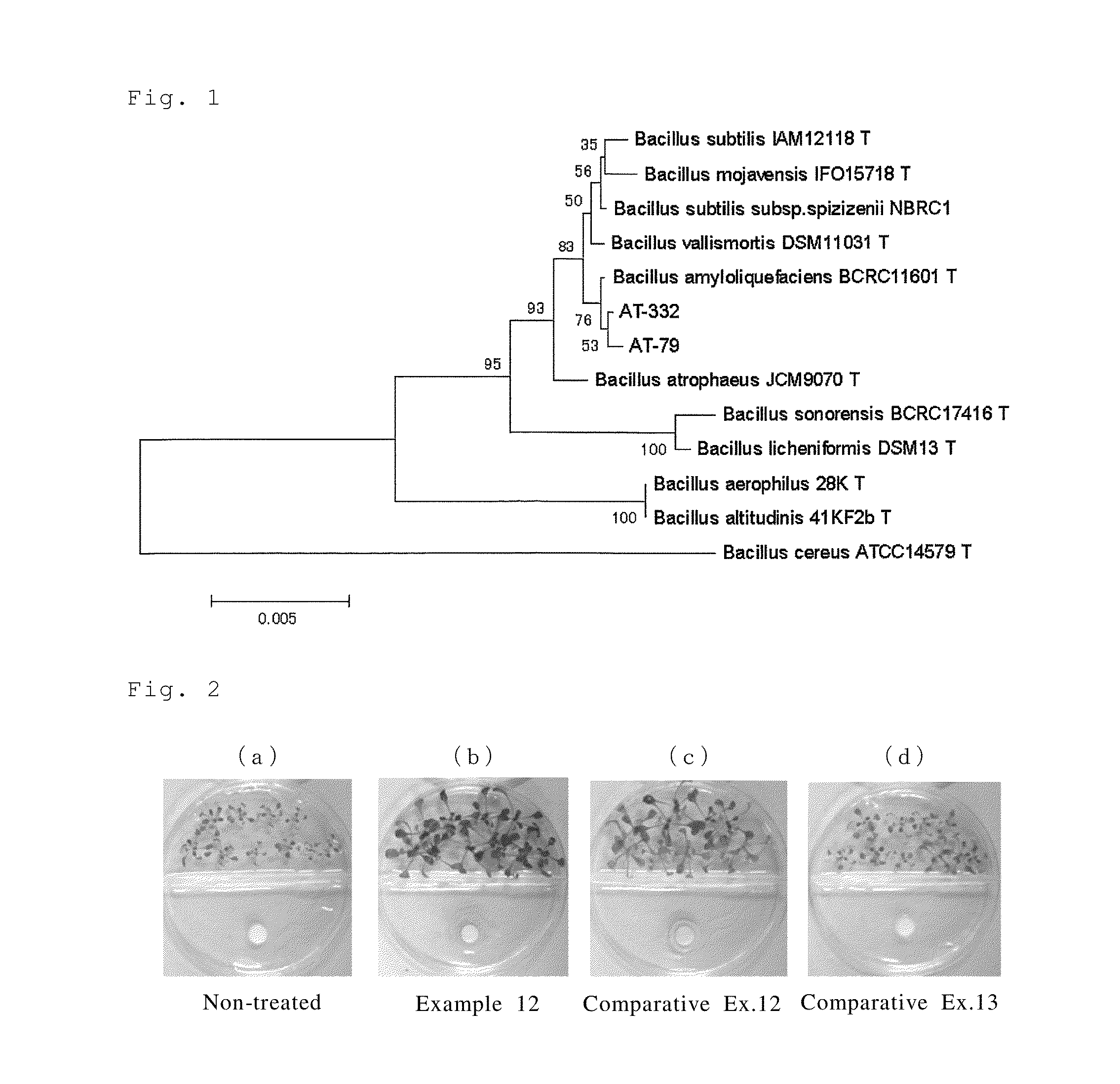Strain belonging to bacillus genus, microbiological agent, and plant cultivation method
a technology of bacillus genus and microorganisms, applied in the field of new microorganisms, can solve the problems of difficult control of bacterial diseases, unstable effect, and difficult to fully control the impact on the environment, and achieve the effect of promoting the growth of useful plants
- Summary
- Abstract
- Description
- Claims
- Application Information
AI Technical Summary
Benefits of technology
Problems solved by technology
Method used
Image
Examples
production example 1
Cultivation and Preparation of AT-332 Strain
[0136]As a preculture, one loopful of the preserved bacteria of the present invention (AT-332 strain) was inoculated on 60 ml per flask of a nutrient broth medium (available from Eiken Chemical Co., Ltd.) in a 500 ml conical flask with baffles, and subjected to shaking culture using a rotary shaker at 180 rpm and 28° C. for one day.
[0137]60 ml of the culture obtained by the above preculture was inoculated in a jar fermentor with a 5000 ml volume containing a 2,000 ml of LB medium (20 g of peptone, 10 g of yeast extract, 20 g of sodium chloride and water for the rest) and cultivated as the main culture at 500 rpm, aeration rate of 1 l / hour and 35° C. for three days.
[0138]About 1,800 g of culture was obtained by the above main culture. The concentration of the bacteria cell was about 8.0×109 CFU / ml.
[0139]About 140 g of dry powder was obtained by freezing 1,800 g of the obtained culture product at −80° C., followed by freeze-drying under redu...
production example 2
Cultivation and Preparation of AT-79 Strain
[0140]As a preculture, one loopful of the preserved bacteria of the present invention (AT-79 strain) was inoculated on 60 ml per flask of a nutrient broth medium (available from Eiken Chemical Co., Ltd.) in a 500 ml conical flask with baffles, and subjected to shaking culture using a rotary shaker at 180 rpm and 28° C. for one day.
[0141]60 ml of the culture obtained by the above preculture was inoculated in a jar fermentor with a 5000 ml volume containing a 2,000 ml of LB medium (20 g of tryptone, 10 g of yeast extract, 20 g of sodium chloride and water for the rest) and cultivated as the main culture at 500 rpm, aeration rate of 1 l / hour and 35° C. for three days.
[0142]About 1,700 g of culture was obtained by the above main culture. The bacteria cell concentration of the powder was about 9.0×109 CFU / g.
[0143]About 130 g of dry powder was obtained by freezing 1,700 g of the obtained culture product at −80° C., followed by freeze-drying under...
formulation example 1
[0145]60 parts of dry powder obtained by Formulation Example 1, 25 parts of diatom earth, 5 parts of white carbon, 8 parts of lignin sulfonate and 2 parts of alkyl naphthalene sulfonate were mixed and pulverized to thereby obtain wettable powder.
PUM
 Login to View More
Login to View More Abstract
Description
Claims
Application Information
 Login to View More
Login to View More - R&D
- Intellectual Property
- Life Sciences
- Materials
- Tech Scout
- Unparalleled Data Quality
- Higher Quality Content
- 60% Fewer Hallucinations
Browse by: Latest US Patents, China's latest patents, Technical Efficacy Thesaurus, Application Domain, Technology Topic, Popular Technical Reports.
© 2025 PatSnap. All rights reserved.Legal|Privacy policy|Modern Slavery Act Transparency Statement|Sitemap|About US| Contact US: help@patsnap.com


